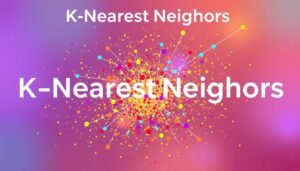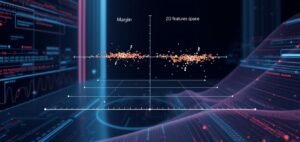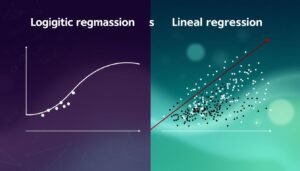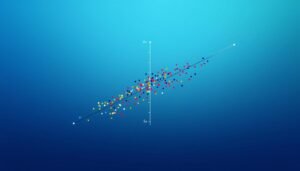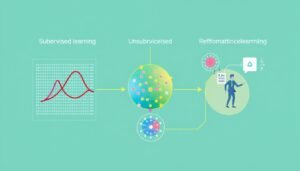In today’s world, knowing the difference between data science and data analytics is key. Both are vital for businesses to make smart choices. Data science uses math, stats, and computer science to find insights in big data. Data analytics looks at specific data to answer specific questions.
Data scientists work with unstructured data, creating complex algorithms and machine learning models. They predict outcomes and solve business problems. Data analysts, on the other hand, work with structured data, finding patterns and trends to guide business decisions.
The need for data science and analytics experts is growing in many fields. Data scientists need skills in programming languages like Python and R, and experience with big data platforms. Data analysts must be good at statistical analysis software, databases, and data visualization tools. Both aim to make data useful, but they do it in different ways.
Key Takeaways
- Data science focuses on big picture insights from large datasets
- Data analytics examines specific data to answer targeted questions
- Both fields support data-driven decision making in businesses
- Data scientists often need advanced degrees and programming skills
- Data analysts typically work with structured data and statistical tools
- High demand exists for both data science and analytics professionals
Understanding the Fundamentals of Data Science and Analytics
In today’s world, knowing the basics of data science and analytics is key for businesses to stay ahead. These fields help companies find valuable insights in their data. This leads to better decisions and strategies.
What Is Data Science?
Data science mixes programming, statistics, and machine learning to find important insights in big datasets. It uses data mining, statistical analysis, and data modeling to solve big problems and predict trends.
What Is Data Analytics?
Data analytics looks at existing data to make conclusions and support business decisions. It cleans, transforms, and analyzes data to find patterns. This gives insights for decision-makers.
The Evolution of Data-Driven Decision Making
The rise of big data has changed how businesses work. Now, companies use data-driven strategies to stay ahead. This makes data science and analytics more important in business today.
| Aspect | Data Science | Data Analytics |
|---|---|---|
| Focus | Predictive modeling | Historical data analysis |
| Tools | Python, R, Machine Learning | SQL, Excel, Tableau |
| Skills | Programming, Statistics, AI | Data Visualization, Reporting |
| Output | Algorithms, Models | Reports, Dashboards |

As businesses make more data, the need for data science and analytics experts grows. These professionals are key in turning data into insights. These insights drive innovation and growth in many industries.
Core Differences: Data Science vs. Data Analytics
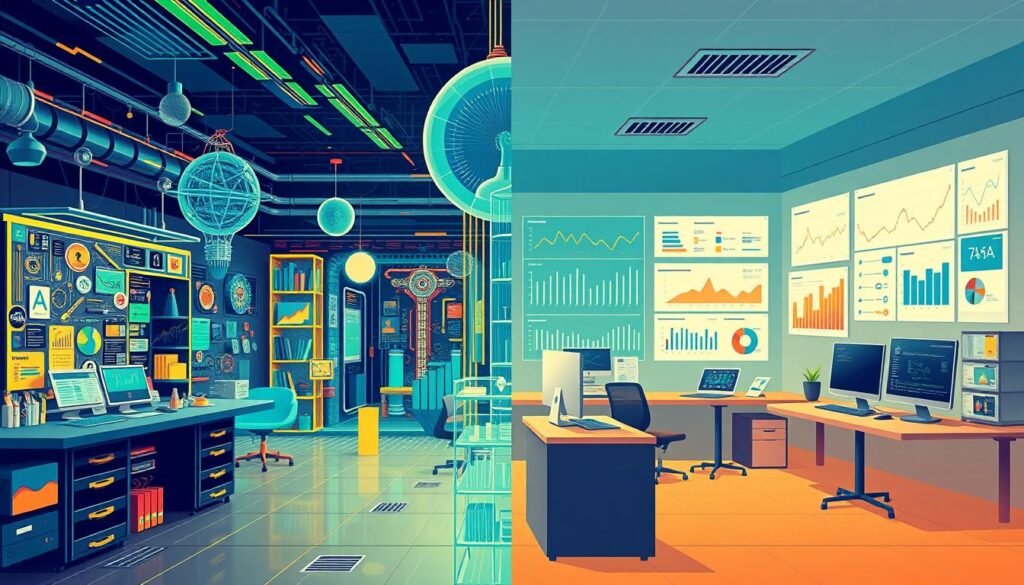
Data science and data analytics are closely related but have different roles. Data science explores and predicts using complex algorithms on unstructured data. On the other hand, data analytics answers specific business questions with structured data.
Data scientists are skilled in programming and create new models. They work with large data sets and use tools like Python and R. Their job covers the whole data process, from gathering to deploying models.
Data analysts are great at understanding data and sharing insights. They use tools like Excel and BI dashboards for analysis. Their main goal is to make quick improvements based on current data.
| Aspect | Data Science | Data Analytics |
|---|---|---|
| Focus | Predictive modeling, data exploration | Business insights, specific questions |
| Scope | Macro, open-ended | Micro, targeted |
| Skills | Advanced programming, statistical techniques | Data interpretation, visualization |
| Average Salary (US) | $120,056 | $95,492 |
Both fields use big data, but they approach it differently. Data science offers initial insights, while data analytics makes these insights useful for business. Knowing how they work together is key for using data well in business.
Essential Skills and Tools for Each Field
The world today is all about data. People who can find important information in big datasets are in high demand. Data science and analytics need different skills and tools to do well.
Data Science Technical Requirements
Data scientists must know a lot about machine learning, coding, and data mining. They often use big data tools like Hadoop and Python for data science projects. The U.S. Bureau of Labor Statistics says data scientist jobs will grow by 35% from 2022 to 2032.
Data Analytics Software and Platforms
Data analysts are all about stats and making data easy to see. They use tools like Tableau, QlikView, and PowerBI. Knowing SQL for data analytics is key for working with databases. Jobs like financial analysts, data analysts, and accountants need these skills.
Programming Languages and Frameworks
R programming and Python are key for data science. Data analysts might prefer Excel and BI tools. Both use data visualization tools to share their findings. Data scientists make about $129,000, while data analysts make $103,250, showing the different needs.
As things change, it’s important to keep learning new tech and improve your skills to stay ahead. The World Economic Forum’s 2023 “Future of Jobs Report” says data analysts and scientists are in high demand.
| Skill | Data Science | Data Analytics |
|---|---|---|
| Programming | Python, R, Java | SQL, Excel |
| Tools | Hadoop, TensorFlow | Tableau, PowerBI |
| Focus | Machine Learning, AI | Business Intelligence |
Career Paths and Job Responsibilities
The data industry is booming, with many job opportunities for data scientists and analysts. These roles have different education, skills, and duties. This shows how diverse the needs of data-driven companies are.
Data analyst jobs usually start with a bachelor’s degree in statistics or mathematics. Newbies can earn around $45,000, while those in mid-career make about $74,353. The top earners can make over $120,000 a year. Analysts mainly work with structured data, looking at past trends.
Data scientist jobs need more education, with 57% having a master’s degree and 12% a Ph.D. This leads to higher pay, with an average salary over $114,141. Top data science leaders can make $165,000 or more. They work with all kinds of data, creating AI models and predicting future trends.
| Aspect | Data Analyst | Data Scientist |
|---|---|---|
| Education | Bachelor’s degree | Master’s or Ph.D. |
| Average Salary | $74,000 | $114,000 |
| Skills Focus | Data cleaning, statistical analysis | Machine learning, AI development |
Both data analyst and data scientist jobs are growing fast. The U.S. Bureau of Labor Statistics says there will be a 23% increase in data analyst jobs and a 35% jump in data scientist jobs by 2032. This shows the big demand for data jobs in many industries.
Real-World Applications and Use Cases
Data science and analytics have changed many industries. They solve complex problems in new ways. Let’s look at some examples and how they are used in real life.
Data Science in Practice
Data science is used in many areas. In healthcare, LYNA, a machine learning tool, found metastatic cancer with 99% accuracy. This shows how data science can help in medical diagnosis.
UPS’s ORION system is another example. It uses AI to save fuel and miles, showing data science’s role in making things more efficient and green.
Data Analytics Implementation
Data analytics also makes a big difference. In sports, RSPCT’s system analyzes basketball shots. It helps teams improve by tracking data from the hoop’s rim.
XPO Logistics uses data to plan better. They predict needs and manage resources, making their supply chain more efficient.
Industry-Specific Examples
Each industry uses data science and analytics in its own way:
- Healthcare: Oncora’s software cuts doctors’ paperwork by up to two-thirds, making work easier.
- Pharmaceuticals: Veeva’s Vault EDC cleans up clinical trial data, allowing for changes during studies.
- Sports: The sports analytics market is growing fast, with WHOOP tracking athletes’ health with wearable tech.
| Industry | Application | Impact |
|---|---|---|
| Healthcare | AI-driven cancer detection | 99% accuracy in trials |
| Logistics | Route optimization | 100 million miles saved annually |
| Sports | Performance analytics | $8.4 billion market by 2026 |
These examples show how data science and analytics are changing industries. They drive innovation and help make better decisions in many fields.
The Role of Machine Learning and AI
Machine learning and AI have changed how we get insights from data. They are key to making decisions based on data in many fields.
Machine Learning in Data Science
Machine learning is a big part of data science. It lets computers learn from data without being told how. Data scientists use it to find patterns, predict outcomes, and do complex tasks.
Predictive Analytics Applications
Predictive modeling uses machine learning to guess what will happen next based on past data. Finance, healthcare, and retail use it to predict customer behavior, assess risks, and forecast demand.
AI Integration and Benefits
AI makes data analysis faster and more accurate. It helps with text and image analysis. This makes it easier to get insights and make better decisions.
| Application | Machine Learning Algorithm | Benefits |
|---|---|---|
| Customer Segmentation | K-means Clustering | Targeted Marketing |
| Fraud Detection | Random Forest | Reduced Financial Losses |
| Product Recommendation | Collaborative Filtering | Increased Sales |
As AI and machine learning get better, they will play an even bigger part in data science. This will open up new ways for businesses to use data.
Data Processing and Analysis Methods
In the world of data science and analytics, many methods are used to find valuable insights. Data mining is key, finding patterns in big datasets. It often uses statistical analysis methods to spot trends and connections.
Data warehousing is important for storing and managing lots of structured data. It’s the base for business intelligence and analytics tools. By keeping data in one place, companies can do complex queries and make reports fast.
- Data cleaning to remove inconsistencies and errors
- Data integration from multiple sources
- Data transformation to prepare for analysis
- Feature engineering to create new variables
Statistical analysis is key in data science and analytics. It helps experts make sense of data and make smart choices. Common methods include regression analysis, hypothesis testing, and time series analysis.
| Tool Category | Examples |
|---|---|
| Data Analytics | R, Tableau Public, Python, SAS |
| Data Science | Jupyter, Matplotlib, TensorFlow, BigML |
| Data Mining | Rapid Miner, Orange, Knime, ELKI |
New techniques like machine learning and artificial intelligence are being added to data work. These new tools help with better predictive models and automated choices.
Business Impact and ROI
Data-driven decisions are changing businesses worldwide. The global data science market is growing fast. This shows how valuable business intelligence insights are becoming.
Companies use advanced analytics to improve forecasts, cut risks, and reach the right audience.
Measuring Success in Data Projects
Good data projects lead to better decisions and a competitive edge. Companies track key metrics to see how their data efforts are doing. They look at revenue, cost savings, and how well things run.
Cost-Benefit Analysis
When looking at data projects, companies think about:
- Infrastructure costs
- Personnel expenses
- Potential revenue gains
- Operational improvements
The average company deals with about 163 terabytes of data. This highlights the need for smart data handling and analysis.
Implementation Strategies
Good data project implementation means:
- Aligning with business goals
- Ensuring data quality
- Creating a data-driven culture
- Using advanced tools like AI and simulation
By using these strategies, businesses can boost profits, make operations smoother, and make better strategic choices.
| Business Area | Data Analytics Impact |
|---|---|
| Marketing | Improved customer segmentation and targeted campaigns |
| Finance | Enhanced financial forecasting and risk management |
| Operations | Optimized supply chain and predictive maintenance |
| Customer Service | Personalized experiences and improved engagement |
As businesses keep using data, the value of data projects grows. Data insights are key for better customer experiences and more efficient operations in all areas.
Future Trends and Industry Evolution
The evolving analytics landscape is changing the future of data science. Big data trends are leading to a big shift in how companies use information.
Python is leading in data science. It has seen over 51.8 billion package downloads in 2023. It’s the favorite language for 66% of data scientists. Job postings for Python skills have also increased by 44%.
Real-time analytics is changing many industries. Snowflake’s Snowpipe streaming cuts down latency by 10x for quick data access. Google’s PubSub streams data directly into BigQuery. Databricks’ Unity Catalog makes managing data lakes easier.
- Machine learning and AI are changing healthcare and manufacturing
- Data observability platforms automate monitoring and quality control
- Cloud technology offers scalable solutions for data storage and processing
No-code and low-code tools are making data science more accessible. Platforms like Obviously AI let non-technical people make data-driven choices. This change, along with ML and AI in data platforms, is changing the industry.
“The future of data science lies in the convergence of advanced analytics, ethical considerations, and accessible tools for all.”
Looking ahead, quantum computing will change data analysis with its power. This, along with new predictive analytics, will lead to more innovation in data science.
Choosing Between Data Science and Analytics
Deciding between data science and analytics careers can be tough. Both fields are exciting, but they need different skills and fit various industries.
Assessment Criteria
Think about your strengths and what you enjoy. Data science needs top-notch programming and math skills. On the other hand, data analytics focuses on business smarts and talking clearly.
| Skill | Data Science | Data Analytics |
|---|---|---|
| Programming | Advanced (Python, R, Apache Spark) | Intermediate (SQL, Excel, Tableau) |
| Mathematics | Advanced (Machine Learning, Deep Learning) | Intermediate (Statistics, Visualization) |
| Business Acumen | Moderate | High |
| Communication | Important | Critical |
Industry Requirements
Different fields need different data skills. Tech companies want data scientists for new products. Finance and marketing often look for data analysts. Think about where you want to work.
Personal Career Goals
What you want to achieve in your career is key. If you love machine learning, data science might be for you. If you enjoy finding insights and making business plans, data analytics could be better.
“Choose a career that aligns with your passions and strengths. Both data science and analytics offer rewarding paths for those who love working with data.”
Your choice should match your skills, the industry’s needs, and your goals. Whether you go for data science or analytics, keep learning and being flexible. These fields change fast.
Conclusion
The debate between data science and data analytics shows two important areas in our future. Data science uses complex algorithms and predictive models. Data analytics, on the other hand, focuses on finding useful insights from data. Both are key in shaping business strategies and driving innovation.
Career opportunities in these fields are growing fast. Data analysts make between $65,000 to $95,000 a year. Data scientists can earn $95,000 to $120,000 or more in the U.S. Your choice depends on your interests, skills, and goals.
Data analysts are good at statistical techniques and tools like SQL and Tableau. Data scientists need to know a lot about machine learning and AI. As we become more data-focused, the demand for these skills will increase.
Whether you’re interested in data science’s predictive power or data analytics’ practical insights, both fields are promising. The important thing is to choose based on your strengths and the industries you care about.



